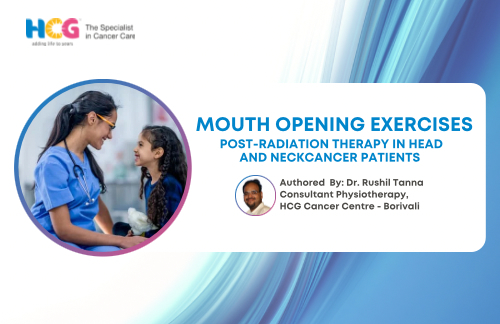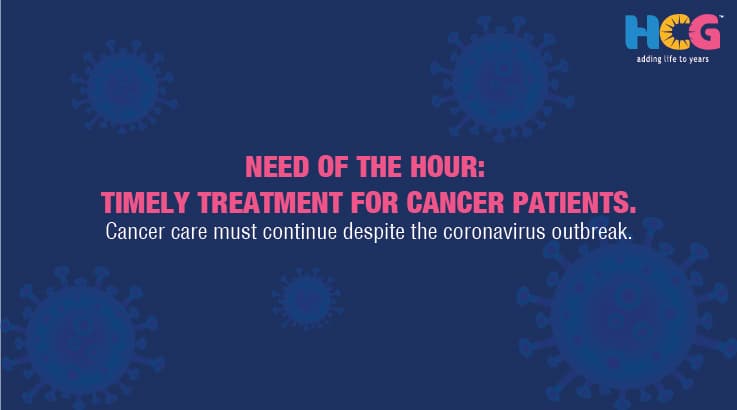
12 Nov, 2024

12 Nov, 2024

This article is medically reviewed by Dr. Rushil Tanna, Consultant – Onco Physiotherapy, HCG Cancer Centre, Borivali.
Head and neck cancer exercises are an important part of the multidisciplinary rehabilitation recommended for head and neck cancer survivors. However, many survivors fail to understand that care beyond cancer treatment is crucial for their recovery and a faster return to normal activities.
Head and neck cancer survivors experience several side effects after head & neck cancer surgery; the severity, however, varies from one patient to another.
Many of these side effects limit neck and shoulder movements and significantly lower the quality of life for patients. Therefore, it is imperative to opt for physiotherapy after the head and neck surgery.
The radiation beams damage cancer cells by destroying the genetic material that controls how they grow and divide.
In this article, we will try to understand the possible reasons for the movement limitations among head and neck cancer surgery patients, the different types of head and neck cancer exercises that these patients can perform for better recovery, and the benefits of performing exercises after neck surgery.
The movements of the neck and shoulder become limited for various reasons. The spinal accessory nerve controls the trapezius muscle, a large muscle that assists in shoulder elevation. When this nerve is injured/resected, it can lead to limited movement of the shoulders.
Some patients may experience reduced shoulder motion just after the surgery; in others, it occurs for a few weeks post-surgery.
Patients experiencing drainage and inflammation at the surgery site also have a reduced range of motion.
That said, the degree of movement dysfunction depends on the head and neck surgery complexity.
Several studies have reported the importance of rehabilitation after neck and head cancer surgery. It helps prevent stiffness and allows quick recovery. Apart from this, it also prevents certain complications of the surgery, such as the formation of blood clots.
Opting for exercises after head and neck cancer surgery can help patients with early mobilization, reducing dependency on others for routine activities. Exercises improve fitness levels and enhance the overall quality of life.
Improved wound healing is another key advantage of exercising after head and neck cancer treatment. Apart from exercises, other physiotherapeutic interventions also help reduce pain and overcome restricted movement.
Cancer treatment can be physically and mentally distressing. Performing exercises does not only relieve fatigue, body pain, and discomfort but also help manage stress, anxiety, and depression.
Dr. Rushil Tanna
Several types of exercises are available to improve the range of motion after head and neck cancer surgery, and they are broadly categorized under neck exercises and shoulder exercises.
Performing exercises after neck surgery can positively impact the overall well-being of neck cancer survivors. The doctor may recommend performing the neck exercises 2-3 times a day. The patient is advised to perform each exercise for at least five minutes. However, if the patient is not feeling well or is tired, they can stop exercising.
The following neck exercises are recommended for those who have undergone surgery for head and neck cancer:
Also referred to as head rotation exercises, neck rotation exercises are crucial to address the stiffness in this region and reduce discomfort. The patient should lie on their back with a pillow supporting the head. They should move their necks sideways until a maximum stretch is felt on the opposite side.
Stop at this position for 2–3 seconds. Then move the neck to the other side to repeat the process.
This is one of the crucial head and neck cancer exercises. In this exercise, the patient is expected to lie on their back and tilt their head on one side of the shoulder in such a way that the ears are near the shoulder.
Wait 2-3 seconds in the same position, and then move the neck back to the normal position. The patient then moves the neck to the other side to repeat the exercise.
The patient may also use their hands to maximally stretch the neck.
During this exercise, the patient should sit straight and move their head backward. The patient shall remain in this position for 2–3 seconds and then move their head back to the normal position.
Then the patient bends their head forward so that their chin approaches the chest.
Some of the exercises to improve the motion of the shoulders are:
In this exercise, the patient moves their shoulders in a circular motion, i.e., moving their shoulders up and backward.
During this exercise, the patient sits straight and extends their hands to the sides.
The patient then squeezes the shoulder blades together and waits in the same position for about 5–6 seconds. The patient then relaxes and repeats the exercise.
The patient lies on their back with a pillow supporting the head. Then, they stretch their hands above the head with a straight elbow.
The patient should keep their shoulders in the same position for a few seconds and then relax.
In this exercise, the patient sits upright. Then, they move their shoulders above their ears.
The patient must hold the same position for 2–3 seconds and then relax.
Swallowing exercises for head and neck cancer survivors can restore their ability to drink and eat liquids and solid foods. Some of the important swallowing rehabilitation exercises are:
Exercise can benefit head and neck cancer survivors in numerous ways. Starting from reducing pain and discomfort to improving the overall mental well-being, head and neck exercises are going to help patients with a faster return to their routine activities.
Different exercises that head and neck cancer survivors can adopt to their rehabilitation regimen include neck exercises, shoulder exercises, and swallowing exercises.
The frequency at which you can perform rehabilitation exercises depends on the type of exercise, the extent of the treatment undergone, the specific needs of the patient, and the patient’s overall health status.
All the head and neck cancer exercises recommended above are low- and mid-intensity exercises, and these can be performed several times a week.
Low-Intensity Exercises: Low-intensity exercises promote healing, reduce pain and swelling, manage fatigue, and maintain the basic range of motion of body parts. These exercises can be performed 3–5 times a day.
Mid-Intensity Exercises: Mid-intensity exercises help improve muscle strength and physical function, enhance sleep quality, relieve pain, and improve sleep quality. Mid-intensity exercises can be performed 3–5 times a week.
To benefit the fullest extent of rehabilitation exercises, patients must opt for individualized exercise plans developed by experienced physiotherapists.
Many patients experience shoulder or scapular dysfunction after undergoing surgery for neck and head cancer due to inflammation or injury to the spinal accessory nerve and various other reasons. It is important to incorporate head and neck cancer exercises as a part of the rehabilitation strategy to manage pain, promote early recovery, reduce dependency, and improve the overall quality of life.
Swallowing Exercises for Patients with Head and Neck Cancer
Exercise-based rehabilitation on functionality and quality of life in head and neck cancer
survivors. A systematic review and meta-analysis
Prehabilitation in head and neck cancer patients: a literature review
Rehabilitation Management of Head and Neck Cancers
A Comprehensive Review of Head and Neck Cancer Rehabilitation: Physical Therapy Perspectives

Author Bio : Dr. Rushil Tanna
Dr. Rushil Tanna is a highly skilled physiotherapist with expertise in managing pre- and post-operative cancer patients. His primary area of interest is oncology rehabilitation. He works closely with medical and surgical oncologists to provide optimal care and rehabilitation to patients. He has worked with over 200 post-operative head and neck cancer patients, helping them to recover and regain function following their surgeries.
To book an appointment with Dr. Rushil, click here.
